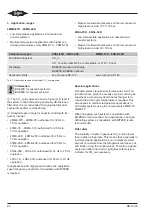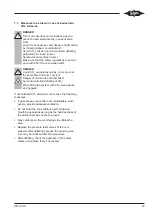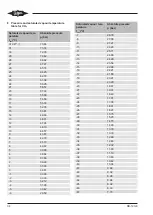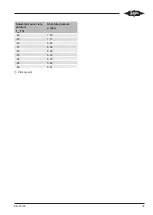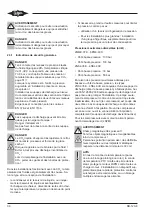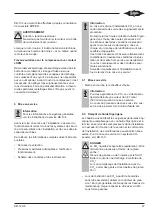
KB-120-8
32
6.3.1
Checking the operating data
After successful commissioning and charging of refri-
gerant, check the operating data and create a data pro-
tocol:
• Evaporation temperatures and high pressure – see
application limits KP-120 and KP-122.
• Suction gas temperature, discharge gas temperature
and oil temperature, see chapter Operating temper-
atures and lubrication conditions, page 32.
• Cycling rate:
– max. 6 starts per hour
– min. time for a start / stop cycle = 10 min
• Current values of all phases.
• Voltage.
Create a data protocol.
7
Operation
7.1
Operating temperatures and lubrication
conditions
!
!
NOTICE
Operation at low pressure ratios and low suction
gas superheat results in low discharge gas and
oil temperatures.
Danger of insufficient lubrication due to the high
solubility of CO
2
in oil.
Avoid operation at low pressure ratios and low
suction gas superheat.
With respect to the lubrication conditions, the following
requirements must be complied with:
• Always use an oil heater, particularly during stop
phases.
• Minimum suction gas superheat 20 K – provide an
heat exchanger if necessary.
• Oil temperature 30°C (20°C = absolute minimum
value!).
• Minimum discharge gas temperature = condensing
temperature (t
c
) + 40K.
For continuous operation, the oil temperature must
not fall below 30°C and pressure gas temperature
not below 50°C!
• Maximum discharge gas temperature: measured at
the discharge gas pipeline (10 cm distance from the
discharge gas connection of the compressor):
– 2MME-07K .. 6PME-40K: 140°C
– 2NSL-05K .. 4NSL-30K: 140°C
7.2
Regular tests
Check the system at regular intervals according to na-
tional regulations. Check the following points:
• Operating data, see chapter Compressor start, page
• Oil supply, see chapter Compressor start, page 31.
• Protection devices and all components for com-
pressor monitoring (check valves, discharge gas
temperature limiters, differential oil pressure
switches, pressure limiters, etc.).
• Tight seat of electrical cable connections and
screwed joints.
• Screw tightening torques.
• Check refrigerant charge.
• Tightness test.
• Update data protocol.
Moreover observe the following points:
• Replace the pressure relief valves of the com-
pressors after deflating because the opening pres-
sure may be reduced after this procedure.
• Check the sight glass and its joint at regular intervals
and replace them if necessary.
• Check the opto-electronic oil monitoring (OLC-K1) at
regular intervals and replace it, if necessary.
• Check the cylinder banks. Dismount the cylinder
heads, check the valve plate and replace it, if neces-
sary.
!
!
NOTICE
Risk of damage to the compressor.
Tighten screws and nuts only to the prescribed
tightening torque and, if possible, crosswise in
at least 2 steps.
Perform a tightness test before commissioning!





